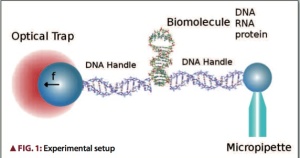At 9:10 AM, the lab next door was blasting “Born to Be Wild.”
I was at Oxford, moonlighting as a visiting researcher during fall 2013. My hosts included quantum theorists in Townsend Laboratory, a craggy great-uncle of a building. Poke your head out of the theory office, and Experiment would flood your vision. Our neighbors included laser wielders, ion trappers, atom freezers, and yellow signs that warned, “DANGER OF DEATH.”
Hardly the neighborhood Mr. Rogers had in mind.
The lab that shared a wall with our office blasted music. To clear my head of calculations and of Steppenwolf, I would roam the halls. Some of the halls, that is. Other halls had hazmat warnings instead of welcome mats. I ran into “RADIATION,” “FIRE HAZARD,” “STRONG MAGNETIC FIELDS,” “HIGH VOLTAGE,” and “KEEP THIS TOILET NEAT AND TIDY.” Repelled from half a dozen doors, I would retreat to the office. Kelly Clarkson would be cooing through the wall.
“We can hear them,” a theorist observed about the experimentalists, “but they can’t hear us.”
Experiment should test, disprove, and motivate theories; and theory should galvanize and (according to some thinkers) explain experiments. But some theorists stray from experiment like North America from Pangaea.
The theoretical physics I’ve enjoyed is abstract. I rarely address platforms, particular physical systems in which theory might incarnate. Quantum-information platforms include electrons in magnetic fields, photons (particles of light), ion traps, quantum dots, and nuclei such as the ones that image internal organs in MRI machines.
Instead of addressing electrons and photons, I address mathematics and abstract physical concepts. Each of these concepts can incarnate in different forms in different platforms. Examples of such concepts include preparation procedures, evolutions, measurements, and memories. One preparation procedure defined by one piece of math can result from a constant magnetic field in one platform and from a laser in another. Abstractness has power, enabling one idea to describe diverse systems.
I’ve enjoyed wandering the hills and sampling the vistas of Theory Land. Yet the experimentalist next door cranked up the radio of reality in my mind. “We can hear them,” a theorist said. In Townsend Laboratory, I began listening. My Oxford collaborators and I interwove two theoretical frameworks that describe heat transferred and work performed on small scales. One framework, one-shot statistical mechanics, has guest-starred on this blog.
The other framework consists of fluctuation relations, which describe deviations from average behaviors by small physical systems. A quantum particle on one side of a wall has a tiny probability of tunneling through without boring any hole. Since the probability is tiny, the average particle doesn’t tunnel (during any reasonably short amount of time). When analyzing macroscopic systems—say, the roughly 1024 atoms that form your left thumbnail—we assume that every particle behaves like the average particle. We can’t when analyzing minuscule systems such as one short strand of DNA. Deviations from average behaviors appear in experimental data about small systems as they do not appear in data about large systems. Fluctuation relations help us understand those deviations.
My colleagues and I addressed “information,” “systems,” and “interactions.” We deployed abstract ideas, referencing platforms only when motivating our work. Then a collaborator challenged me to listen through the wall.
Experimentalists have tested fluctuation relations. Why not check whether their data supports our theory? At my friend’s urging, I contacted experimentalists who’d shown that DNA obeys a fluctuation relation. The experimentalists had unzipped and re-zipped single DNA molecules using optical tweezers, which resemble ordinary tweezers but involve lasers. Whenever the experimentalists pulled the DNA, they measured the force they applied. They concluded that their platform obeyed an abstract fluctuation theorem. The experimentalists generously shared their data, which supported our results.

Experimentalists unzipped and rezipped DNA to test fluctuation relations. This depiction of the set-up comes from this article.
My colleagues and I didn’t propose experiments. We didn’t explain why platforms had behaved in unexpected ways. We checked calculations with recycled data. But we ventured outside Theory Land. We learned that one-shot theory models systems modeled also by fluctuation relations, which govern experiments. This link from one-shot theory to experiment, like the forbidden corridors in Townsend Laboratory, invite exploration.
In Townsend, I didn’t suffer the electric shocks or the explosions advertised on the doors (though the hot water in the bathroom nearly burned me). I turned out not to need those shocks. Blasting rock music at 9:10 AM can wake even a theorist up to reality.



“optical tweezers, which resemble ordinary tweezers but involve lasers”
One of the advantages of being a physicist, the ability to casually mention lasers as if they’re nothing special. 🙂
Ha! Absolutely. We may not have the highest salaries, but we have perks!
Pingback: Generally speaking | Quantum Frontiers
Pingback: I spy with my little eye…something algebraic. | Quantum Frontiers
Pingback: Mingling stat mech with quantum info in Maryland | Quantum Frontiers
Pingback: Discourse in Delft | Quantum Frontiers
Pingback: Life, cellular automata, and mentoring | Quantum Frontiers
Pingback: What matters to me, and why? | Quantum Frontiers
Awesome!!
Pingback: It’s CHAOS! | Quantum Frontiers
Pingback: What’s the worst that could happen? | Quantum Frontiers
Pingback: Theoretical physics has not gone to the dogs. | Quantum Frontiers
Pingback: “A theorist I can actually talk with” | Quantum Frontiers
Pingback: One equation to rule them all? | Quantum Frontiers